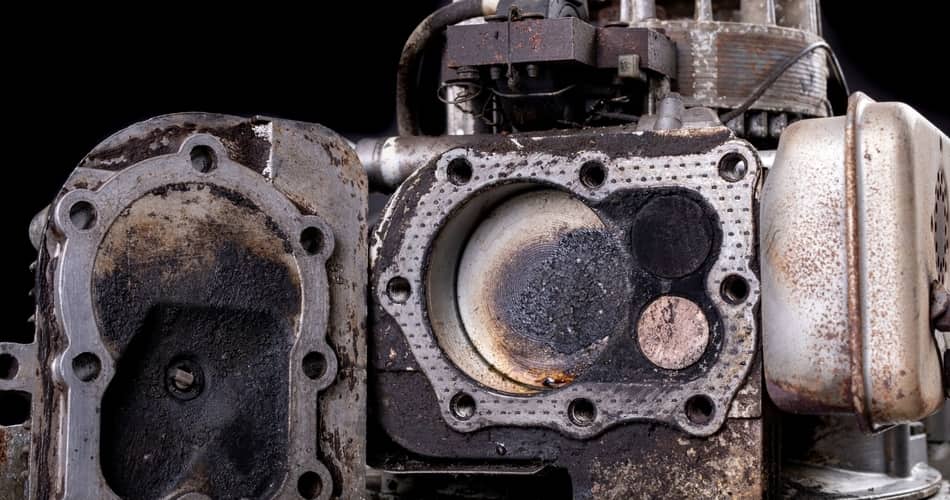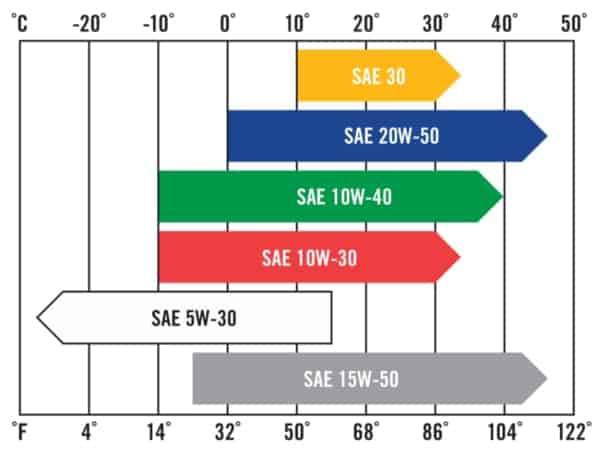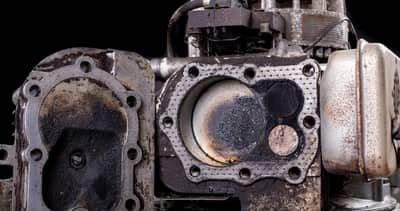Have you ever noticed while you are mowing your lawn your lawn mower is smelling a little hot? It is not a normal use type of hot, but it is smelling like it is running way too hot. Engines are very expensive so it is best to stop the engine and figure out why this is happening before you cause greater engine damage
A lawn mower may be overheating when the wrong oil is used; the engine is low on oil or components on your engine are broke or blocked including the cooling fins, air filter and engine guards. Operating your lawn mower in heavy wet grass can overwork your engine causing it to overheat.
Let me help you address these items and fix a lawn mower that overheats by cleaning debris and dirt from the engine area, replacing the air filter and other items that may overwork the engine.

This post may include affiliate links. Purchases made through these links may provide a commission for us, at no extra cost to you. As an Amazon Associate, we earn from qualifying purchases.
Follow all safety instructions provided in your equipment operator’s manual prior to diagnosing, repairing, or operating.Consult a professional if you don’t have the skills, or knowledge or are not in the condition to perform the repair safely.
Why Does Your Lawn Mower Overheat?
1. Using the Wrong Kind of Engine Oil
Engine oil has a lot to do with keeping our engines cool. You may have heard people say oil is oil. This is not true anymore. The engine used in the lawn mower today utilizes an air cooled engine oil with a high concentrate of zinc. Zinc is an additive used as a cooling agent.
Regular motor oil does not include much zinc because it is used in engines that use water in a liquid to cool the engine.
This chart will give you an idea of what type of oil works best in different temperatures. Use this chart and consult with your owner’s manual for the manufacturer’s recommendation for oil as these recommendations will vary from these recommendations.
Most manufacturer’s will recommend using SAE30 or 10W-30 engine oil in your lawn mower engine, but you may need to change your oil viscosity to a 20W50 when operating in higher ambient temperatures.

2. Engine is Low on Engine Oil
Cause:
Running your lawn mower with low oil will cause additional friction in the engine. This friction can cause your mower to overheat.
If you run your engine too long with low oil this oil because thicker and can cause significant internal engine damage. If you don’t change or check your oil on a regular schedule you can cause engine damage.
Fix:
- Regularly perform engine oil changes to keep your engine running at its best.
- Check your engine oil level before each use and add if your oil level is lower than recommended by the manufacturer. If you continually lose engine oil, you will need to address this as discussed in this article.
- Check for oil leaks. If you are consistently low on oil you need to check to see if you are leaking oil, burning oil, or consuming oil.
- Oil Leak – Look over the engine area to find signs of an engine oil leak. Once you find the cause of the leak, replace the gaskets from which the oil is coming. You will also want to inspect your filter if your mower uses one. Make sure your oil filter is sealing properly.
- Burning Oil – Check for a plugged air filter. A plugged air filter will cause oil to burn from the engine making the engine work harder. You can clean the air filter or replace it is very dirty and unable to be cleaned.
- Using Oil – An engine can be used oil due to overheating while in use. It can also be an indication of a valve or ring problem. You need to take your mower to a repair center for an engine diagnosis.
3. Engine Fins are Damaged or Clogged
Typically you don’t really look at the fins on our engine, but a small engine mechanic looks at them when annual maintenance is completed. It’s good to take a look at the fins going forward to ensure they are not broken or clogged with dirt.
Cause:
When the fins are broken or get clogged with dirt, grass, and engine oil, the engine cannot pass air around the exterior of the engine cylinder heads and engine block. This lack of air will cause your engine to overheat.
- The top of the engine has a fan on it. It pulls fresh cool air in and then blows it down toward the bottom of the engine.
- The air passes through all of the hot parts of the engine and then blows the hot air out of the bottom.
There is really no way to avoid getting debris into the engine when grass and dirt are flying in the air every time you mow.
Washing your engine can further add to the problem by pushing dirt and water into the engine area. When washing your mower do not spray water into the engine to avoid compounding the problem.
Fix:
Every fall you need to remove the engine covers and clean out the cooling fins. If you choose not to do this, you need to take it to your local lawn mower repair shop to have this done with your regular maintenance.
4. Engine Guard Not in Place
Cause:
Check to make sure your engine guard is still in place and that a screw hasn’t fallen out to make the guard move out of place.
If a screw did come out and you don’t bother to replace it to move the guard in the position it is supposed to be mounted you may find your engine isn’t getting the cool air it needs to cool down.
Because the cool air is exiting out of the area where the shield is no longer mounted, the area around the engine will remain hot. The shield isn’t in place to keep the cool air around the engine area.
Fix:
Check the engine shield regularly to make sure it does not become loose or out of place. Tighten or replace mounting screws to keep the shield in place.
5. Plugged Air Filter
Cause:
Having a plugged air filter will cause your mower’s engine to not run well and most likely run hot because the engine is starving for air. The engine runs hotter because it is working harder to breathe.
Fix:
Inspect your air filter. Shine a flashlight through the filter. If you can see a good amount of light through the filter, your filter is ok. If the light is very dull or nonexistent when shone through the filter, you should replace it with a new air filter.
I recommend replacing the air filter a couple of times a year. You may need to change it more frequently if you operate your lawn mower in dusty conditions.
Some lawn mower engines come with an inner air filter or a pre-cleaner filter. The inner air filter is a narrower filter that fits inside a canister-style air filter. A pre-cleaner is often a foam filter that is placed around the outside of the filter to help keep dirt from entering the engine area.
Some people don’t like spending money on maintenance items for a lawn mower and the first thing they skip is the air filter. The air filter is a pretty cheap part when compared to having to fix or replace an engine due to foreign debris reaching the engine cavity.
6. Dull Blades
Cause:
Blades that are dull and rounded will put a bigger load on the lawn mower engine. This bigger load will cause the engine to create more heat while mowing.
Fix:
It’s a good idea to check your blades regularly, not only for damage but also for wear on the blades. Dull blades will cause your lawn to not have a nice appearing cut and may even turn your lawn brown by beating up the grass instead of giving each blade of grass a nice precise cut.
For more about inspecting and sharpening your mower blades, read my article here.
7. Mower Deck Full of Debris
Cause:
For the same reason, dull blades will cause your engine to overwork, and a mower deck full of debris will also cause your engine to work harder and possibly overheat.
Grass and dirt build-up underneath the mower deck may cause the blades to not spin freely and continue to jam or work harder to rotate through the debris.
Fix:
Clean your deck regularly and inspect it for damage. Use a deck scraper or remove the debris. There isn’t a product on the market that will keep all dirt and debris from sticking to the underside of your deck, but you can help prevent it by doing the following:
- Always run your lawn mower at full throttle
- Avoid cutting wet grass
- Regularly cut your lawn so the grass doesn’t get too long and result in clumping of grass
- Coat the underside of your mower deck with a Teflon or silicone spray designed for your lawn mower deck
8. Overworking the Engine
Cause:
Running your lawn mower in long grass or in thick wet grass will cause your engine to be overworked and possibly overheat.
Fix:
Allow your grass to dry before you cut it. Not only will you put less stress on your lawn mower’s engine, but you will also have a nice-looking lawn with less clumping of grass left in the yard.
If your grass becomes very long, it will be best to double or triple-cut your lawn. This process involves setting your deck at a higher height and mowing your yard, followed by setting the deck height a little lower and cutting your lawn again.
By making multiple cuts you will not be attempting to cut an overgrown yard in one cutting.
Let Engine Cool After Lawn Mowing
When operating a riding lawn mower, it’s important to let the engine cool before placing it back into a storage unit or garage. It is best to open the hood of the mower in an outdoor area. Let the mower run under no load. The normal engine cooling process will begin to cool your engine down.
Learn more about engine cooling times and factors that affect engine cooling with our article, “Lawn Mower Engine Cooling Times Explained“.
Still Having Problems with Your Lawn Mower?
Lawn mower ownership doesn’t come without its frustrations. Own a lawn mower long enough, you are bound to run into many lawn mower problems including starting, smoking, leaking, cutting, and overheating.
For a list of the most common lawn mower problems and items that can cause them, check out my guide “Common Lawn Mower Problems: Solved!“
